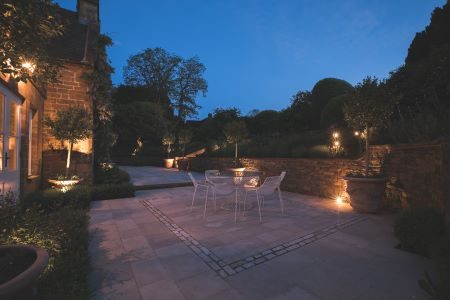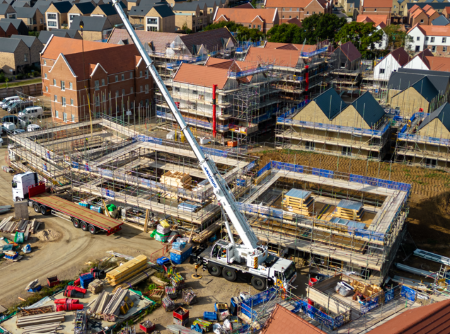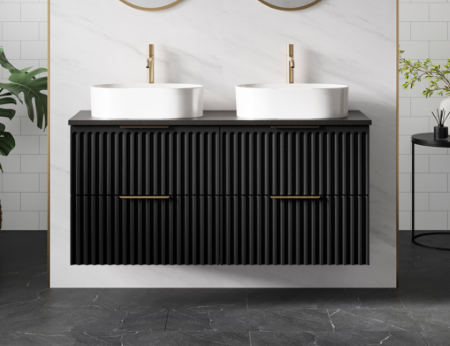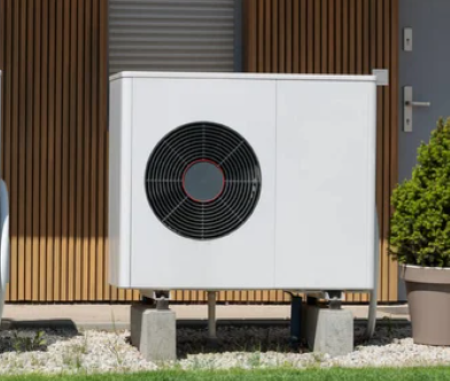With summer upon us, Showhome Editor Joseph Clarke shares his bright ideas for gardens, enabling homeowners to enjoy their time outdoors, both day and night, come rain or shine
An unreliable climate like that of the UK can be the cause of distress and upset, as homeowners find themselves cooking under umbrellas one minute, determined not to cancel their BBQ plans; or spraying themselves with sprinklers the next, in a desperate attempt to cool off during an unexpected heatwave. Whatever the weather, gardens and outdoor spaces are very much valued and loved by homeowners across the nation, perhaps even more so since COVID19 reminded us of just how lucky we are to be able to roam freely outside; even luckier being those who can do so without leaving their own premises.
Outdoor spaces are an excellent addition to any home, offering an enormous variety of functions, from alfresco dining with friends and family to fun and games with the kids. For housebuilders, designing a home’s outdoor space can feel like putting the cherry on the cake. With options for both garden designs and functions seemingly endless, this really is an exciting and motivating part to the housebuilding process.
As summer has now officially begun, and temperatures have already become notably warmer, we can expect homeowners with gardens, patios, or terraces to be spending more and more time outside. Those looking to buy a new home over the summer will be equally interested in what the outside has to offer, so what better time than now to look at some of the top ideas for getting the most enjoyment from a home’s outdoor space?
Day
For hot summer days, cool shaded areas are a necessity, especially for homeowners with children. There are many ways to create a shaded sanctuary for entertaining, playing, or relaxing in the garden, with price ranges varying depending on the complexity and the materials of the structure. For smaller outdoor spaces, shade is still very much an option, but flexibility is key.
Parasols, sails and retractable awnings are a great choice for smaller spaces, particularly as they can be moved or taken down when more light is needed to enter the home. While fixed structures offer several advantages, they obviously cannot be moved or put down, so while the shade will be appreciated outdoors during the summer heat, when inside the home, homeowners might be restricted for light, as less direct sunlight is able to enter in through the windows and back doors.
Retractable and/or movable shading solutions such as awnings also offer flexibility to housebuilders when it comes to design. Parasols, sails and awnings can be used as the perfect way to add a splash of colour to a calmer, discrete outdoor area, or soften down an already colourful outdoor space through neutral and soft-patterned designs.
Natural cover is a highly favoured option for both house designers and homeowners. These spaces offer beauty and really draw you in, providing both protection from the sun and peace and tranquillity, as the welcome breeze gently rustles the leaves.
One way to create a natural shaded area is through the careful selection and placement of trees. Ash trees are fast growing, can reach heights of up to 25 metres, and grow well all over the UK. Another great choice is the Silver Birch. This beautiful, silver-bark shader is extremely popular due to its airy shape that helps to provide the shade and privacy desired, while still letting a good amount of light through. Common alternatives include Hawthorns, Hornbeams, Field Maples, Beech Trees, Yews and Ashes.
However, designers at Homes and Gardens favour a different variety of tree, including the Oak and the Willow, claiming that “the mighty oak is one of the best trees for shade, and treasured by gardeners around the world”, while “few trees are as evocative of lazy summer days than the weeping willow – Salix babylonica – which provides a protective branch canopy that’s perfect for picnicking beneath.” The downside, however, is that they need a lot of space – something which is not always the case in new-build developments.
Pergolas are also a fantastic way to increase the usability of an outdoor space during the summertime. Traditionally, they consist of a wooden frame made up of four posts and an open-slatted roof. However, these are not the best in terms of protection from the heat of the sun, and will definitely not stand a chance at keeping you dry during a downpour. Fortunately, there are plenty of pergola shade ideas that will indeed provide the desired amount of protection, from both the sun and the rain.
With natural beauty again playing an integral role, growing climbing plants over the roof of a pergola will create a seating area that is incredibly cool during the hottest times of the year. These structures look wonderful, give off pleasant aromas, and more importantly, allow for day and night outdoor enjoyment. Once the plants are in full growth and flower, there might be some relief from very gentle rain, but cannot be relied on to protect during heavier rainfall. That said, there is a fairly simple solution to this problem – a roofed pergola that incorporates both impermeable materials and plants. One option to create a pergola such as this would be to cover the middle area of the pergola with a solid material and then grow plants up and around the roof border. Alternatively, you might prefer to divide the area of the pergola into two, with one part being covered with anti-rain solutions and the other part with climbing plants.
Roofing a pergola with a solid roof is one of the easiest and best ways to create outdoor space, when fixed structures are a feasible and option, given the size of the area. A wooden roof offers durability and affordability, while being aesthetically appealing. Versatile metals can also be used, with each one bringing a unique set of advantages and disadvantages.
Night
With areas now installed to enable daytime enjoyment in the fresh air without getting wet or too hot, the next priority is to ensure that homeowners can continue to enjoy themselves once the sun has gone down and temperatures drop.
Lighting can totally transform any space, so it makes sense to give outdoor lighting just as much attention as indoor. Apart from the obvious benefit, that will allow for homeowners to keep enjoying their time outside after the sun has gone down, lights can be used to draw attention to specific features, to illuminate paths and to make gardens safer. Garden lighting is fun to play around with, with the power to completely change the way you look at your outdoor space and the plants that are in it. For garden lighting schemes to be successful, working together effectively with wildlife and structures, they need to be carefully planned in advance. It is therefore most definitely a responsibility that house builders should not overlook when they are designing and creating new homes.
To create the right lighting schemes, it is important to first identify the focus areas. These might be a particular plant/tree, wall textures, columns, paths, water features or outdoor structures, such as outdoor cooking areas or sheds and summer houses. It is these focus areas that will benefit most from outdoor lights. Lighting is not simply there to make an outdoor space safe and usable after dusk. Just like indoors. Light fixtures should also be treated as an accessory, with the power to add modern elegance to areas, and showcase other features around them.
A highly practical choice for outdoor lighting is wall lights. Wall lighting can enhance the safety and security of a home and also bring an outdoor space to life. They can also come with a variety of features, including PIR sensors and timers, and can be made from high-quality materials like natural copper or high-grade stainless steel.
Step lights help to increase the safety of your steps during the evenings and come in a variety of designs. Strip lights can be installed between the steps, while recessed and wall lights can be fitted to the walls, shining light onto the steps from each side. This type of outdoor lighting is not only a good safety measure, it also looks great, drawing your eye through the steps and into the space beyond.
Another bright idea for anywhere in the outdoor area is recessed lights. They are elegant, discrete and multi-functional, and can be used to light up garden features, pathways, driveways and much more. A further benefit to this lighting system is that. As they are installed into the surface, they are not a trip hazard, and therefore safe to be used anywhere around the outdoor area.
Using good quality fittings is essential. Once a scheme has been designed and the type of lighting chosen, it is important to look at IP ratings. This is a number that classifies a mechanical or electrical enclosure in terms of its protection against foreign bodies and elements. In other words. The higher the first digit is, the better the lighting product is for shielding from solid objects. The higher the second digit is, the more protection it will have against moisture.
The finishing touch to ensure an outdoor space is fully functional both day and night comes from a heating solution. Again, this is not just something that can be incorporated into larger areas. Thanks to better technology and modern, chic designs, outdoor heating can give an extra touch of magic to any new build garden or patio area.
Outdoor fireplaces have pretty much the same characteristics as indoor ones, following the same construction methods as well as using the same materials. One minor difference is that outdoor fireplaces can come without a chimney. While designs can be more complex, to create elaborate brick-built set-ups that perfectly imitate their indoor sibling, simpler designs can also be used to save time, money and space. What is great about outdoor fireplaces is that they can also be designed and installed for the additional purpose of cooking.
Although brick fireplaces will stand out as a fabulous focal point in an outdoor space, they can be costly and are obviously a permanent fixture. If a cheaper or more flexible alternative is preferred, then there are also options available.
A free-standing fireplace can give an outdoor area a centrepiece, without having to use permanent fixtures. Iron fireplaces are a wonderful addition to a home’s outdoor space as they are both compact and eye-catching. Comprising of a wood-burning furnace and a grill sitting above, this is the perfect example of how an outdoor heater can also serve as a cooking appliance.
While some newbuilds do not have the luxury of having outdoor space, there are others which do benefit but to a limited degree. For smaller areas, it is advisable to find heating sources that are safe for both children and pets. Hanging patio heaters work perfectly in these cases, as they are suspended from the roof of a covered terrace or other roofed areas, like pergolas, for example. Of course, whether or not they can be fitted to a pergola will depend on the type of roofing it has and will also require intelligent placing, away from materials that could catch fire.
The best thing about electric hanging heaters is that they use infrared technology, so the heat is radiated downwards onto anyone sitting underneath. The heat supply is also very constant and there is minimal heat loss, so they are a cost-effective option.
For daytime enjoyment throughout the summer, homeowners need accessible outdoor areas that can withstand the rain and keep out the heat. This is achievable no matter the size of the outdoor space, whether it be a tiny patio or a larger garden. For areas restricted by space, fabric canopies are the perfect solution. Specialist outdoor fabrics that are used for awnings, parasols or sails, are economical, showerproof, and UV resistant. For larger spaces, creating shaded, dry areas with natural resources and pants/trees is a must. Not only will these areas offer protection from the elements, but they will be incredibly pleasing for the senses. When night falls, homeowners need not take cover from the inside of their homes, but instead can continue enjoying their time outdoors long into the night, with the help of lovely lighting and handy heating.
Read more news and exclusive features in our latest issue here.
Never miss a story… Follow us on:
Showhome
@Your_Show_Home
@Showhomemag
Media Contact
Joseph Clarke
Editor, Showhome
Tel: +44 (0) 1622 823 920
Email: editor@yourshow-home.com






